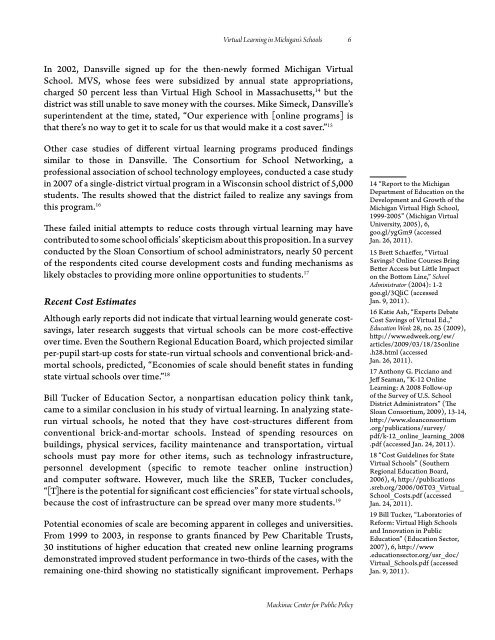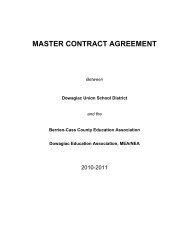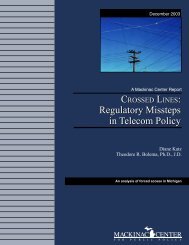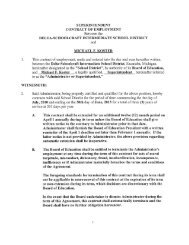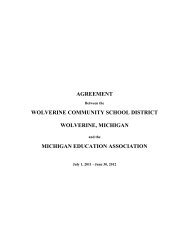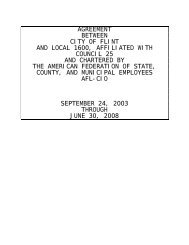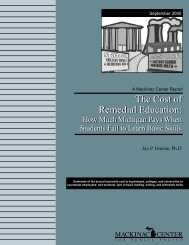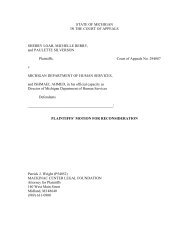by Michael Van Beek - Michigan Virtual University
by Michael Van Beek - Michigan Virtual University
by Michael Van Beek - Michigan Virtual University
You also want an ePaper? Increase the reach of your titles
YUMPU automatically turns print PDFs into web optimized ePapers that Google loves.
<strong>Virtual</strong> Learning in <strong>Michigan</strong>’s Schools 6In 2002, Dansville signed up for the then-newly formed <strong>Michigan</strong> <strong>Virtual</strong>School. MVS, whose fees were subsidized <strong>by</strong> annual state appropriations,charged 50 percent less than <strong>Virtual</strong> High School in Massachusetts, 14 but thedistrict was still unable to save money with the courses. Mike Simeck, Dansville’ssuperintendent at the time, stated, “Our experience with [online programs] isthat there’s no way to get it to scale for us that would make it a cost saver.” 15Other case studies of different virtual learning programs produced findingssimilar to those in Dansville. The Consortium for School Networking, aprofessional association of school technology employees, conducted a case studyin 2007 of a single-district virtual program in a Wisconsin school district of 5,000students. The results showed that the district failed to realize any savings fromthis program. 16These failed initial attempts to reduce costs through virtual learning may havecontributed to some school officials’ skepticism about this proposition. In a surveyconducted <strong>by</strong> the Sloan Consortium of school administrators, nearly 50 percentof the respondents cited course development costs and funding mechanisms aslikely obstacles to providing more online opportunities to students. 17Recent Cost EstimatesAlthough early reports did not indicate that virtual learning would generate costsavings,later research suggests that virtual schools can be more cost-effectiveover time. Even the Southern Regional Education Board, which projected similarper-pupil start-up costs for state-run virtual schools and conventional brick-andmortalschools, predicted, “Economies of scale should benefit states in fundingstate virtual schools over time.” 18Bill Tucker of Education Sector, a nonpartisan education policy think tank,came to a similar conclusion in his study of virtual learning. In analyzing staterunvirtual schools, he noted that they have cost-structures different fromconventional brick-and-mortar schools. Instead of spending resources onbuildings, physical services, facility maintenance and transportation, virtualschools must pay more for other items, such as technology infrastructure,personnel development (specific to remote teacher online instruction)and computer software. However, much like the SREB, Tucker concludes,“[T]here is the potential for significant cost efficiencies” for state virtual schools,because the cost of infrastructure can be spread over many more students. 19Potential economies of scale are becoming apparent in colleges and universities.From 1999 to 2003, in response to grants financed <strong>by</strong> Pew Charitable Trusts,30 institutions of higher education that created new online learning programsdemonstrated improved student performance in two-thirds of the cases, with theremaining one-third showing no statistically significant improvement. Perhaps14 “Report to the <strong>Michigan</strong>Department of Education on theDevelopment and Growth of the<strong>Michigan</strong> <strong>Virtual</strong> High School,1999-2005” (<strong>Michigan</strong> <strong>Virtual</strong><strong>University</strong>, 2005), 6,goo.gl/ygGm9 (accessedJan. 26, 2011).15 Brett Schaeffer, “<strong>Virtual</strong>Savings? Online Courses BringBetter Access but Little Impacton the Bottom Line,” SchoolAdministrator (2004): 1-2goo.gl/3QliC (accessedJan. 9, 2011).16 Katie Ash, “Experts DebateCost Savings of <strong>Virtual</strong> Ed.,”Education Week 28, no. 25 (2009),http://www.edweek.org/ew/articles/2009/03/18/25online.h28.html (accessedJan. 26, 2011).17 Anthony G. Picciano andJeff Seaman, “K-12 OnlineLearning: A 2008 Follow-upof the Survey of U.S. SchoolDistrict Administrators” (TheSloan Consortium, 2009), 13-14,http://www.sloanconsortium.org/publications/survey/pdf/k-12_online_learning_2008.pdf (accessed Jan. 24, 2011).18 “Cost Guidelines for State<strong>Virtual</strong> Schools” (SouthernRegional Education Board,2006), 4, http://publications.sreb.org/2006/06T03_<strong>Virtual</strong>_School_Costs.pdf (accessedJan. 24, 2011).19 Bill Tucker, “Laboratories ofReform: <strong>Virtual</strong> High Schoolsand Innovation in PublicEducation” (Education Sector,2007), 6, http://www.educationsector.org/usr_doc/<strong>Virtual</strong>_Schools.pdf (accessedJan. 9, 2011).Mackinac Center for Public Policy


